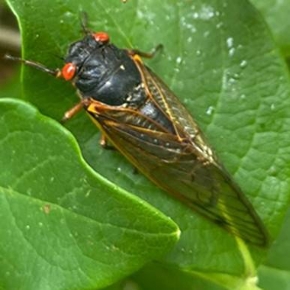They’re coming! And whether you consider the Brood X cicada (Magicada cassini) swarm a wonder of nature or a major annoyance, we can expect their visit to be brief and loud! There are a few things that you can do to prepare, and a few facts that can help you understand the cicada life cycle that will help you meet the event with patience and knowledge.
After living underground, not asleep but actively living through about 4 phases of life cycle, the cicada will emerge in huge numbers to grow to mature to adult form, mate and lay eggs for the next 17-year cycle. Indiana is reported to be in the heart of the cicada outbreak this year.
According to Dr. Gene Kritsky, Dean of the School of Behavioral and Natural Sciences at Mount St. Joseph University, the emergence typically occurs in the first half of May, usually between the 12th and 15th, or when the soil temperature reaches 64 degrees, especially after a good drenching rain. Then, they begin to emerge, mostly males at first so they can mature. They shed their shells while molting leaving them to cover trees, bushes and yards.
During the 2004 outbreak, Kritsky measured about 356 cicadas emerging per square yard in the Cincinnati area. Bloom Magazine, from another source, reported that here in Bloomington the count was closer to 200 cicadas per square meter. Either way, that translates to billions of bugs! This is a fine feast for wildlife, birds and pets! Animals and birds who find them a tasty treat are said to gorge themselves on the cicadas. So, if your pet doesn’t seem hungry, you may know why.
How about humans eating them? Humans have devised dozens of ways to prepare cicadas, and you may want to give them a taste. Cicadamania.com advises humans to pass on nature’s treat, or at least, not to consume very many because they are a source of mercury in the diet.
About five days after emergence the males who have survived the animal feast will begin to sing to attract a mate. Their call is loud, sometimes as high as 96 decibels, louder than a passing jet, Kritsky writes. And, oh, by the way, if you are outside mowing the lawn during the day or using power tools that create a vibration, as, of course, they will, expect to attract or even be dive-bombed by male cicadas who will mistake you for a female of their species! Try to confine yardwork to early morning or later in the evening when the bugs will be less inclined to bother you. You may want to wear a hat when you are outside. If you find yourself feeling moisture falling on you while outside, it could be cicada pee, which is affectionately named “honeydew”!
The females who emerged a little later will mate and then lay their eggs a day or two later. Then both male and female cicadas die. The whole process from emergence to death takes around four weeks. The eggs take about 8 weeks to hatch at which time the nymphs will fall to the ground and burrow into the soil. By early fall they will have established themselves about a foot below the soil line where they will live for the next seventeen years.
The cicada has five eyes, two large and three small that are often red, but may be almost any color except green. They grow long wings and can fly high into the trees to lay their eggs. Large trees will be able to take care of themselves although they may experience some branch damage that will appear as areas of dead brown leaves. Smaller, weaker trees and young bushes and shrubs may be more vulnerable. Experts suggest covering them with netting, especially fruit trees whose sweet sap will attract the cicadas. Since the cicadas fly, such deterrents as tanglefoot, often used for ant control on trees and bushes, will not be effective.
If you are interested in helping science, you can download a phone app called Cicada Safari which will allow you to report Brood X outbreaks to Dr. Krinsky and to submit GPS-tagged photos that will allow scientists to sturdy what they look like, how they act and how long they stayed among other things. More activities for kids and adults can be found at CicadaSafari.org (reported by the Lloyd Library, Cincinnati, OH).
Note:Dr. Kritsky, who took his BA in Biology at Indiana University and his Ph.D. in Entomology from University of Illinois, has a new book entitled Periodical Cicadas: the Brood X Edition (Ohio Biological Society) available in print and on Kindle. Lloydiana, a publication of the Lloyd Library was a major source of information for this article.


